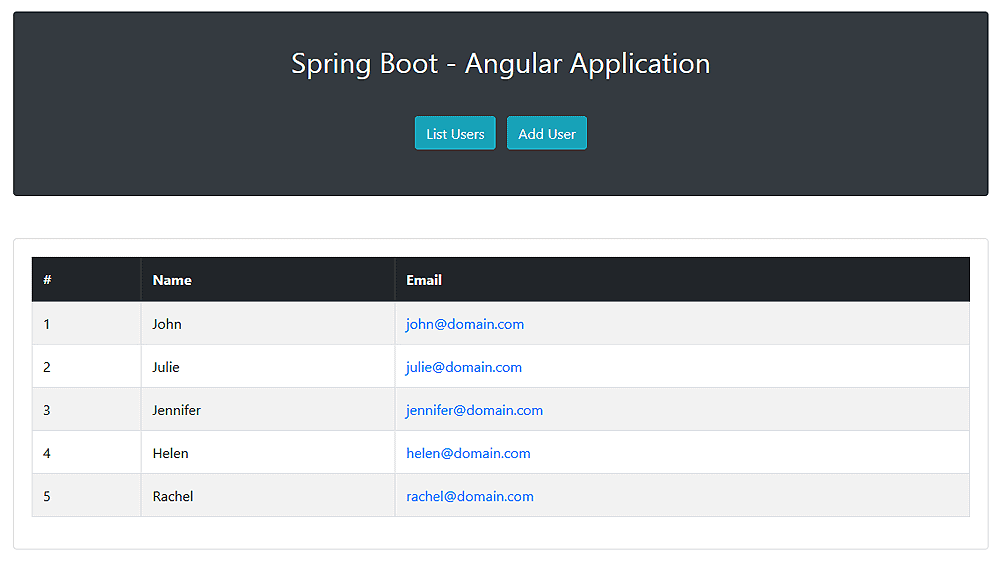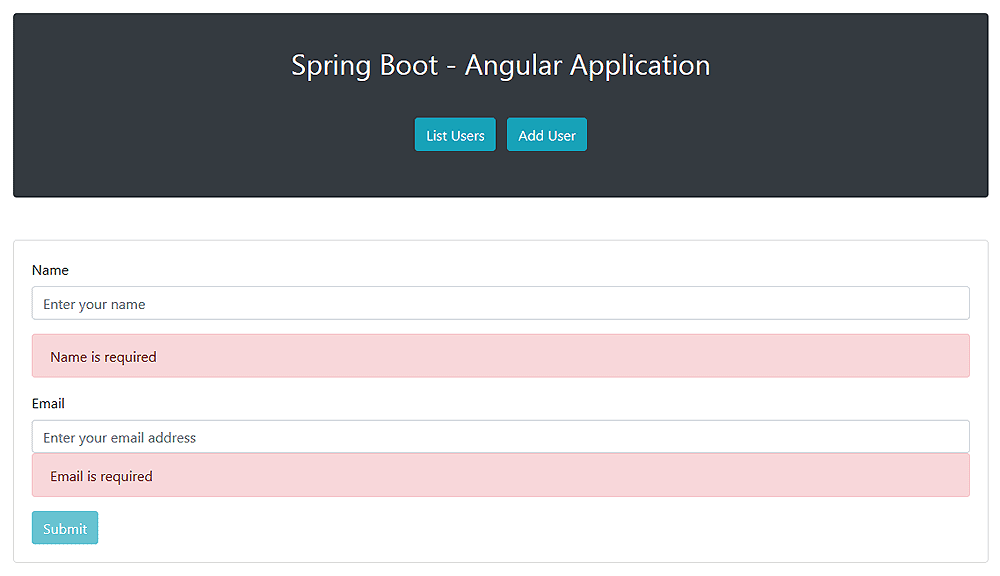一、概述
Spring Boot和Angular形成了一个强大的组合,非常适合开发占用空间最小的 Web 应用程序。
在本教程中,我们将使用Spring Boot实现 RESTful 后端,并使用Angular创建基于 JavaScript 的前端。
延伸阅读:
Spring 中的接口驱动控制器
了解如何在 Java 接口上使用 Spring MVC 请求注解创建控制器。
阅读更多→
Spring REST API + OAuth2 + Angular
了解如何使用 Spring Security 5 为 Spring REST API 设置 OAuth2,以及如何从Angular客户端使用它。
阅读更多→
2.Spring Boot应用
我们的演示 Web 应用程序的功能确实非常简单。它将缩小到从内存中的H2 数据库中获取和显示JPA 实体列表,并通过纯 HTML 表单持久化新实体。
2.1. Maven 依赖项
这是我们的Spring Boot项目的依赖项:
<dependency>
<groupId>org.springframework.boot</groupId>
<artifactId>spring-boot-starter-web</artifactId>
</dependency>
<dependency>
<groupId>org.springframework.boot</groupId>
<artifactId>spring-boot-starter-data-jpa</artifactId>
</dependency>
<dependency>
<groupId>com.h2database</groupId>
<artifactId>h2</artifactId>
<scope>runtime</scope>
</dependency>
请注意,我们包含了spring-boot-starter-web,因为我们将使用它来创建 REST 服务,并使用spring-boot-starter-jpa来实现持久层。
H2 数据库版本也由Spring Bootparent 管理。
2.2. JPA 实体类
为了快速构建我们应用程序领域层的原型,让我们定义一个简单的 JPA 实体类,它将负责为用户建模:
@Entity
public class User {
@Id
@GeneratedValue(strategy = GenerationType.AUTO)
private long id;
private final String name;
private final String email;
// standard constructors / setters / getters / toString
}
2.3. UserRepository接口_
由于我们需要User实体上的基本 CRUD 功能,因此我们还必须定义一个UserRepository接口:
@Repository
public interface UserRepository extends CrudRepository<User, Long>{}
2.4. REST 控制器
现在让我们实现 REST API。在这种情况下,它只是一个简单的 REST 控制器:
@RestController
@CrossOrigin(origins = "http://localhost:4200")
public class UserController {
// standard constructors
private final UserRepository userRepository;
@GetMapping("/users")
public List<User> getUsers() {
return (List<User>) userRepository.findAll();
}
@PostMapping("/users")
void addUser(@RequestBody User user) {
userRepository.save(user);
}
}
UserController类的定义本身并不复杂。
当然,这里值得注意的实现细节是@CrossOrigin注解的使用。顾名思义,注解在服务器上启用跨源资源共享(CORS)。
此步骤并不总是必要的,但由于我们将Angular前端部署到http://localhost:4200,而我们的 Boot 后端部署到http://localhost:8080,否则浏览器会拒绝从一个到另一个的请求.
关于控制器方法,getUser()从数据库中获取所有用户实体。类似地,addUser()方法在数据库中持久化一个新实体,该实体在请求正文中传递。
为了简单起见,我们在持久化实体之前故意省略了触发Spring Boot 验证的控制器实现。然而,在生产中,我们不能只信任用户输入,因此服务器端验证应该是一项强制性功能。
2.5. 引导Spring Boot应用程序
最后,让我们创建一个标准的Spring Boot引导类,并用一些用户实体填充数据库:
@SpringBootApplication
public class Application {
public static void main(String[] args) {
SpringApplication.run(Application.class, args);
}
@Bean
CommandLineRunner init(UserRepository userRepository) {
return args -> {
Stream.of("John", "Julie", "Jennifer", "Helen", "Rachel").forEach(name -> {
User user = new User(name, name.toLowerCase() + "@domain.com");
userRepository.save(user);
});
userRepository.findAll().forEach(System.out::println);
};
}
}
现在让我们运行应用程序。正如预期的那样,我们应该在启动时看到打印到控制台的用户实体列表:
User{id=1, name=John, email=john@domain.com}
User{id=2, name=Julie, email=julie@domain.com}
User{id=3, name=Jennifer, email=jennifer@domain.com}
User{id=4, name=Helen, email=helen@domain.com}
User{id=5, name=Rachel, email=rachel@domain.com}
3. 角度应用
随着我们的演示Spring Boot应用程序启动并运行,我们现在可以创建一个能够使用 REST 控制器 API 的简单Angular应用程序。
3.1. 角度 CLI 安装
我们将使用强大的命令行实用程序Angular CLI来创建我们的Angular应用程序。
Angular CLI 是一个非常有价值的工具,因为它允许我们从头开始创建整个Angular项目,只需几个命令即可生成组件、服务、类和接口。
一旦我们安装了npm(节点包管理器),我们将打开一个命令控制台并键入命令:
npm install -g @angular/cli@1.7.4
而已。上面的命令将安装最新版本的AngularCLI。
3.2. 使用AngularCLI 搭建项目脚手架
我们可以从头开始生成我们的Angular应用程序结构,但老实说,这是一个容易出错且耗时的任务,我们在所有情况下都应该避免。
相反,我们会让AngularCLI 为我们完成这些繁重的工作。所以我们可以打开一个命令控制台,然后导航到我们想要创建应用程序的文件夹,然后键入命令:
ng new angularclient
新命令将在angularclient 目录中生成整个应用程序结构。
3.3.Angular应用程序的入口点
如果我们查看angularclient 文件夹,我们会看到AngularCLI 有效地为我们创建了一个完整的项目。
Angular 的应用程序文件使用TypeScript ,它是一种类型化的 JavaScript 超集,可以编译为纯 JavaScript。然而,任何Angular应用程序的入口点都是一个普通的旧index.html文件。
让我们编辑这个文件:
<!doctype html>
<html lang="en">
<head>
<meta charset="utf-8">
<title>Spring Boot -AngularApplication</title>
<base href="/">
<meta name="viewport" content="width=device-width, initial-scale=1">
<link rel="icon" type="image/x-icon" href="favicon.ico">
<link rel="stylesheet"
href="https://maxcdn.bootstrapcdn.com/bootstrap/4.0.0/css/bootstrap.min.css"
integrity="sha384-Gn5384xqQ1aoWXA+058RXPxPg6fy4IWvTNh0E263XmFcJlSAwiGgFAW/dAiS6JXm"
crossorigin="anonymous">
</head>
<body>
<app-root></app-root>
</body>
</html>
正如我们在上面看到的,我们包含了Bootstrap 4 ,这样我们就可以让我们的应用程序 UI 组件看起来更漂亮。当然,可以从现有的一堆 UI 工具包中挑选另一个 UI 工具包。
请注意<body>部分中的自定义
我们将把它们放在那里,因为
3.4. app.component.ts根组件
为了更好地理解Angular如何将 HTML 模板绑定到组件,让我们进入src/app目录并编辑根组件app.component.ts TypeScript 文件:
import { Component } from '@angular/core';
@Component({
selector: 'app-root',
templateUrl: './app.component.html',
styleUrls: ['./app.component.css']
})
export class AppComponent {
title: string;
constructor() {
this.title = 'Spring Boot -AngularApplication';
}
}
出于显而易见的原因,我们不会深入学习 TypeScript。即便如此,请注意该文件定义了一个AppComponent类,该类声明了一个字符串类型(小写)的字段标题。毫无疑问,它是类型化的 JavaScript。
此外,构造函数使用字符串值初始化该字段,这与我们在 Java 中所做的非常相似。
最相关的部分是@Component元数据标记或装饰器,它定义了三个元素:
- 选择器 ——用于将组件绑定到 HTML 模板文件的 HTML 选择器
- templateUrl – 与组件关联的 HTML 模板文件
- styleUrls – 与组件关联的一个或多个 CSS 文件
正如预期的那样,我们可以使用app.component.html和app.component.css文件来定义根组件的 HTML 模板和 CSS 样式。
最后,选择器元素将整个组件绑定到包含在index.html文件中的
3.5. app.component.html文件_
由于app.component.html文件允许我们定义根组件的 HTML 模板,即AppComponent类,我们将使用它来创建带有两个按钮的基本导航栏。
如果我们单击第一个按钮,Angular 将显示一个表,其中包含存储在数据库中的用户实体列表。类似地,如果我们单击第二个,它将呈现一个 HTML 表单,我们可以使用它向数据库添加新实体:
<div class="container">
<div class="row">
<div class="col-md-12">
<div class="card bg-dark my-5">
<div class="card-body">
<h2 class="card-title text-center text-white py-3"></h2>
<ul class="text-center list-inline py-3">
<li class="list-inline-item">
<a routerLink="/users" class="btn btn-info">List Users</a>
</li>
<li class="list-inline-item">
<a routerLink="/adduser" class="btn btn-info">Add User</a>
</li>
</ul>
</div>
</div>
<router-outlet></router-outlet>
</div>
</div>
</div>
该文件的大部分是标准 HTML,有一些值得注意的注意事项。
第一个是表达式。双花括号是Angular用于执行变量插值的占位符。
请记住,AppComponent类使用值Spring Boot –AngularApplication初始化了title字段。因此,Angular 将在模板中显示该字段的值。同样,更改构造函数中的值将反映在模板中。
第二个要注意的是routerLink属性。
Angular 使用此属性通过其路由模块路由请求(稍后会详细介绍)。现在,知道模块将向/users路径的请求分派到特定组件并将向/adduser的请求分派到另一个组件就足够了。
在每种情况下,与匹配组件关联的 HTML 模板将在
3.6. 用户类_
由于我们的Angular应用程序将从数据库中获取用户实体并将其持久化,因此让我们使用 TypeScript 实现一个简单的域模型。
让我们打开一个终端控制台并创建一个模型目录:
ng generate class user
Angular CLI 将生成一个空的User类,所以让我们用几个字段填充它:
export class User {
id: string;
name: string;
email: string;
}
3.7. UserService服务_
在我们的客户端域用户类已经设置的情况下,我们现在可以实现一个服务类,该服务类对http://localhost:8080/users端点执行 GET 和 POST 请求。
这将允许我们将对 REST 控制器的访问封装在一个类中,我们可以在整个应用程序中重复使用它。
让我们打开一个控制台终端,然后创建一个服务目录,并在该目录中发出以下命令:
ng generate service user-service
现在让我们打开AngularCLI 刚刚创建的user.service.ts文件并重构它:
import { Injectable } from '@angular/core';
import { HttpClient, HttpHeaders } from '@angular/common/http';
import { User } from '../model/user';
import { Observable } from 'rxjs/Observable';
@Injectable()
export class UserService {
private usersUrl: string;
constructor(private http: HttpClient) {
this.usersUrl = 'http://localhost:8080/users';
}
public findAll(): Observable<User[]> {
return this.http.get<User[]>(this.usersUrl);
}
public save(user: User) {
return this.http.post<User>(this.usersUrl, user);
}
}
我们不需要扎实的 TypeScript 背景知识来理解UserService类的工作原理。简而言之,它将使用我们之前在Spring Boot中实现的 REST 控制器 API 所需的所有功能封装在一个可重用组件中。
findAll()方法通过Angular 的HttpClient向http://localhost:8080/users端点执行 GET HTTP 请求。该方法返回一个包含用户对象数组的Observable实例。
同样,save()方法对http://localhost:8080/users端点执行 POST HTTP 请求。
通过在HttpClient的请求方法中指定用户类型,我们可以更轻松、更有效地使用后端响应。
最后,让我们注意@Injectable()元数据标记的使用。这表明服务应该通过Angular 的依赖注入器创建和注入。
3.8. UserListComponent组件_
在这种情况下,UserService类是 REST 服务和应用程序表示层之间的薄中间层。因此,我们需要定义一个组件,负责呈现保存在数据库中的用户实体列表。
让我们打开一个终端控制台,然后创建一个用户列表目录,并生成一个用户列表组件:
ng generate component user-list
Angular CLI 将生成一个空的组件类,它实现了 ngOnInit接口。该接口声明了一个钩子 ngOnInit()方法,Angular 在完成实例化实现类之后以及调用其构造函数之后调用该方法。
让我们重构这个类,以便它可以在构造函数中获取一个UserService实例:
import { Component, OnInit } from '@angular/core';
import { User } from '../model/user';
import { UserService } from '../service/user.service';
@Component({
selector: 'app-user-list',
templateUrl: './user-list.component.html',
styleUrls: ['./user-list.component.css']
})
export class UserListComponent implements OnInit {
users: User[];
constructor(private userService: UserService) {
}
ngOnInit() {
this.userService.findAll().subscribe(data => {
this.users = data;
});
}
}
UserListComponent类的实现是不言自明的。它只是使用UserService 的 findAll()方法来获取数据库中持久保存的所有实体并将它们存储在用户字段中。
此外,我们需要编辑组件的 HTML 文件user-list.component.html,以创建显示实体列表的表格:
<div class="card my-5">
<div class="card-body">
<table class="table table-bordered table-striped">
<thead class="thead-dark">
<tr>
<th scope="col">#</th>
<th scope="col">Name</th>
<th scope="col">Email</th>
</tr>
</thead>
<tbody>
<tr ngFor="let user of users">
<td></td>
<td></td>
<td><a href="mailto:"></a></td>
</tr>
</tbody>
</table>
</div>
</div>
我们应该注意ngFor指令的使用。该指令称为repeater,我们可以使用它来迭代变量的内容并迭代地呈现 HTML 元素。在本例中,我们使用它来动态呈现表的行。
此外,我们使用变量插值来显示每个用户的id、 name和email。
3.9. UserFormComponent组件_
同样,我们需要创建一个组件,允许我们在数据库中持久化一个新的User对象。
让我们创建一个用户表单目录并键入以下内容:
ng generate component user-form
接下来让我们打开user-form.component.ts文件,并在UserFormComponent类中添加一个保存 User对象的方法:
import { Component } from '@angular/core';
import { ActivatedRoute, Router } from '@angular/router';
import { UserService } from '../service/user.service';
import { User } from '../model/user';
@Component({
selector: 'app-user-form',
templateUrl: './user-form.component.html',
styleUrls: ['./user-form.component.css']
})
export class UserFormComponent {
user: User;
constructor(
private route: ActivatedRoute,
private router: Router,
private userService: UserService) {
this.user = new User();
}
onSubmit() {
this.userService.save(this.user).subscribe(result => this.gotoUserList());
}
gotoUserList() {
this.router.navigate(['/users']);
}
}
在这种情况下,UserFormComponent还在构造函数中获取一个UserService实例,onSubmit()方法使用它来保存提供的User对象。
由于我们需要在持久化新实体后重新显示更新的实体列表,因此我们在插入后调用gotoUserList()方法,它将用户重定向到/users路径。
此外,我们需要编辑user-form.component.html文件,并创建用于在数据库中保存新用户的 HTML 表单:
<div class="card my-5">
<div class="card-body">
<form (ngSubmit)="onSubmit()" #userForm="ngForm">
<div class="form-group">
<label for="name">Name</label>
<input type="text" [(ngModel)]="user.name"
class="form-control"
id="name"
name="name"
placeholder="Enter your name"
required #name="ngModel">
</div>
<div [hidden]="!name.pristine" class="alert alert-danger">Name is required</div>
<div class="form-group">
<label for="email">Email</label>
<input type="text" [(ngModel)]="user.email"
class="form-control"
id="email"
name="email"
placeholder="Enter your email address"
required #email="ngModel">
<div [hidden]="!email.pristine" class="alert alert-danger">Email is required</div>
</div>
<button type="submit" [disabled]="!userForm.form.valid"
class="btn btn-info">Submit</button>
</form>
</div>
</div>
乍一看,这个表单看起来很标准,但它在幕后封装了很多Angular的功能。
让我们注意ngSubmit指令的使用,它在提交表单时调用 onSubmit()方法。
接下来我们定义了模板变量#userForm,因此Angular自动添加了一个NgForm指令,它允许我们将表单作为一个整体进行跟踪。
NgForm指令包含我们为带有 ngModel 指令和名称属性的表单元素创建的控件。它还监视它们的属性,包括它们的状态。
ngModel指令为我们提供了表单控件和客户端域模型(User类)之间的双向数据绑定功能。
这意味着在表单输入字段中输入的数据将流向模型,反之亦然。两个元素的变化将通过 DOM 操作立即反映出来。
此外,ngModel允许我们跟踪每个表单控件的状态,并通过向每个控件添加不同的 CSS 类和 DOM 属性来执行客户端验证。
在上面的 HTML 文件中,我们使用应用于表单控件的属性仅在表单中的值已更改时显示警告框。
3.10. app -routing.module.ts文件
尽管组件是独立运行的,但我们仍然需要使用一种机制在用户单击导航栏中的按钮时调用它们。
这就是RouterModule发挥作用的地方。让我们打开app-routing.module.ts文件并配置模块,以便它可以将请求分派给匹配的组件:
import { NgModule } from '@angular/core';
import { Routes, RouterModule } from '@angular/router';
import { UserListComponent } from './user-list/user-list.component';
import { UserFormComponent } from './user-form/user-form.component';
const routes: Routes = [
{ path: 'users', component: UserListComponent },
{ path: 'adduser', component: UserFormComponent }
];
@NgModule({
imports: [RouterModule.forRoot(routes)],
exports: [RouterModule]
})
export class AppRoutingModule { }
正如我们在上面看到的,Routes数组指示路由器在用户单击链接或在浏览器地址栏中指定 URL 时显示哪个组件。
路由由两部分组成:
- Path——与浏览器地址栏中的 URL 相匹配 的 字符串
- Component——当路由处于活动状态(导航)时要创建的组件
如果用户单击链接到/users路径的List Users按钮,或在浏览器地址栏中输入 URL,路由器将在
同样,如果他们单击“添加用户”按钮,它将呈现UserFormComponent组件。
3.11. app.module.ts文件_
接下来我们需要编辑app.module.ts文件,这样Angular就可以导入所有需要的模块、组件和服务。
此外,我们需要指定我们将使用哪个提供程序来创建和注入UserService类。否则,Angular 将无法将其注入到组件类中:
import { BrowserModule } from '@angular/platform-browser';
import { NgModule } from '@angular/core';
import { AppRoutingModule } from './app-routing.module';
import { FormsModule } from '@angular/forms';
import { HttpClientModule } from '@angular/common/http';
import { AppComponent } from './app.component';
import { UserListComponent } from './user-list/user-list.component';
import { UserFormComponent } from './user-form/user-form.component';
import { UserService } from './service/user.service';
@NgModule({
declarations: [
AppComponent,
UserListComponent,
UserFormComponent
],
imports: [
BrowserModule,
AppRoutingModule,
HttpClientModule,
FormsModule
],
providers: [UserService],
bootstrap: [AppComponent]
})
export class AppModule { }
4. 运行应用
最后,我们准备运行我们的应用程序。
为此,我们将首先运行Spring Boot应用程序,以便 REST 服务处于活动状态并侦听请求。
启动Spring Boot应用程序后,我们将打开命令控制台并键入以下命令:
ng serve --open
这将启动Angular的实时开发服务器,并打开浏览器 http://localhost:4200。
我们应该看到带有用于列出现有实体和添加新实体的按钮的导航栏。如果我们点击第一个按钮,我们应该在导航栏下方看到一个表格,其中包含数据库中保存的实体列表: 同样,点击第二个按钮将显示用于保存新实体的 HTML 表单:

5.总结
在本文中,我们学习了如何使用Spring Boot和Angular构建一个基本的 Web 应用程序。
与往常一样,本教程的完整源代码可在GitHub上获得。
Post Directory

